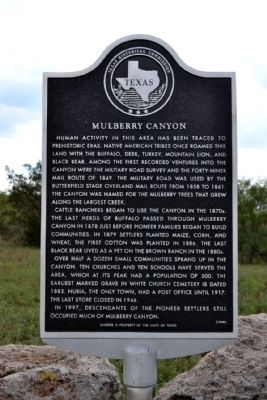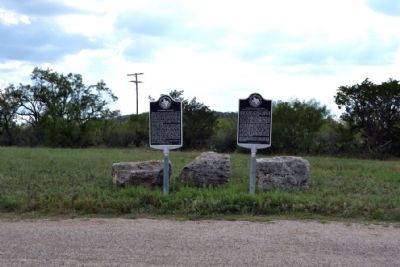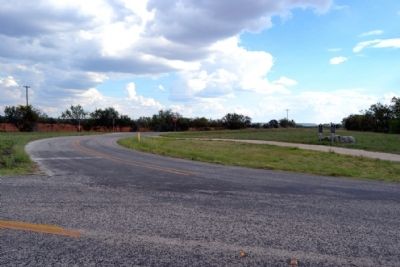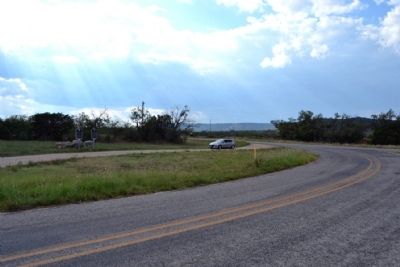Near Merkel in Taylor County, Texas — The American South (West South Central)
Mulberry Canyon
Cattle ranchers began to use the canyon in the 1870s. The last herds of buffalo passed through Mulberry Canyon in 1878 just before pioneer families began to build communities. In 1879 settlers planted maize, corn, and wheat; the first cotton was planted in 1886. The last black bear lived as a pet on the Brown Ranch in the 1880s.
Over half a dozen small communities sprang up in the canyon. Ten churches and ten schools have served the area, which at its peak had a population of 500. The earliest marked grave in White Church Cemetery is dated 1883. Nubia, the only town, had a post office until 1917. The last store closed in 1946.
In 1997, descendants of the pioneer settlers still occupied much of Mulberry Canyon.
Erected 1997 by Texas Historical Commission. (Marker Number 12222.)
Topics. This historical marker is listed in this topic list: Settlements & Settlers. A significant historical year for this entry is 1849.
Location. 32° 24.28′ N, 100° 4.174′ W. Marker is near Merkel, Texas, in Taylor County. Marker is at the intersection of Farm to Market Road 126 and Farm to Market Road 1085, on the right when traveling south on Road 126. Touch for map. Marker is in this post office area: Merkel TX 79536, United States of America. Touch for directions.
Other nearby markers. At least 8 other markers are within 12 miles of this marker, measured as the crow flies. Cornelia Clark Fort (here, next to this marker); Castle Peak (approx. 5.7 miles away); Vicinity of Indian Fight (approx. 5.7 miles away); Mountain Pass Station (approx. 5.9 miles away); Near Site of Indian Battle (approx. 5.9 miles away); Drummond Cemetery (approx. 11.6 miles away); In Vicinity of Coronado's Camp (approx. 11.6 miles away); Butterfield Trail (approx. 11.6 miles away). Touch for a list and map of all markers in Merkel.
Also see . . . Nubia, TX. From the Texas State Historical Association’s “Handbook of Texas Online”. (Submitted on October 6, 2014.)
Credits. This page was last revised on June 16, 2016. It was originally submitted on October 6, 2014, by Duane Hall of Abilene, Texas. This page has been viewed 1,065 times since then and 102 times this year. Photos: 1, 2, 3, 4, 5. submitted on October 6, 2014, by Duane Hall of Abilene, Texas.




